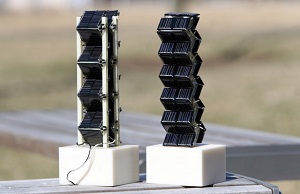MIT develops PV power tower
 With photovoltaics, it’s generally been thought that flat-plate collectors tilted at an angle or mounted to maximize the amount of direct sunlight that hits them are the best way to get the most out of PV.
With photovoltaics, it’s generally been thought that flat-plate collectors tilted at an angle or mounted to maximize the amount of direct sunlight that hits them are the best way to get the most out of PV.
But research conducted at the Massachusetts Institute of Technology (MIT) is showing that 3-D modules, which look much like skinny towers of accordion baffles, produced more than double and up to 20 times more electricity than flat-plate modules.
The work focused on the quality of light collection, rather than simply quantity, according to Nicola Ferralis, a, MIT Department of Materials Science and Engineering research scientist and co-author of the research, which was published in Energy and Environmental Science.
“The optimization of the solar collection in 3-D is achieved by collecting sunlight beyond direct insolation—so also reflected and scattered light,” he said.
Such technology already is somewhat applied to flat panels. Manufacturers texturize their modules’ surface in an attempt to reduce reflection and to increase the absorption of incident light.
“Most of the benefits of our technology is exploited when the third dimension is used. The flexibility of our computational tools, however, can be applied in cases where reflectors are needed, for example, to improve sun collection to a fixed 2-D panel,” Ferralis said. “In a 3-D PV system, each cell is optimized to collect direct sunlight, but also light reflected from other cells or mirrors. In our simulations we show that up to 35 percent of the total power generated from these structures is from light reflected off from other cells.”
Tests also showed that the structures collect more diffuse light and reflected light.
One area where this could have a greater impact is in cities, where ground space and roof space is minimal, according to Ferralis.
“Rethinking the way we install PV modules in buildings in 3-D may provide better ways to deploy solar PV in such environments. For example, buildings smartly coated with PV modules and mirrors on their sides as 3D PV systems may take full advantage of direct and indirect, reflected, illumination,” he said.
An interesting thing about the research is it’s also PV-technology agnostic, according to Ferrallis. He envisioned that the technology could be used with spray-on PV technologies—where the PV is applied to a structure—or flexible PV where the PV is placed into a form, rather than just applying silicon cells to a structure.
Pictured: Two small-scale versions of three-dimensional photovoltaic arrays were among those tested by Jeffrey Grossman and his team on an MIT rooftop to measure their actual electrical output throughout the day. Photo: Allegra Boverman / MIT.



